- Author Arianna Cook [email protected].
- Public 2024-01-12 17:55.
- Last modified 2025-06-01 07:38.
Distinctive features of the plant, advice on growing a stork in open ground, how to propagate a rake, diseases and pests that annoy the plant, facts to note, species. The stork (Erodium) can also be found in botanical literature under the name of the rake. It belongs to the Geraniaceae family and is usually found in natural conditions in the temperate zone of Eurasia and the African continent. At the same time, if we rely on the data provided by The Plant List from 2013, then only 2-3 species can be seen in nature growing in the southern African regions and Australia, and the same number of varieties is very widespread throughout the planet, mainly in temperate climates. Scientists have counted up to 128 species in the genus.
| Family name | Geranium |
| Life cycle | Annual or perennial |
| Growth features | Occasionally herbaceous shrubs |
| Reproduction | Seed and vegetative (cuttings or division of the rhizome) |
| Landing period in open ground | Rooted cuttings, planted in late spring or summer |
| Substrate | Fertile with a weak lime reaction |
| Illumination | Open area with bright lighting |
| Moisture indicators | Moisture stagnation is harmful, watering is moderate, a drainage layer is recommended |
| Special Requirements | Unpretentious |
| Plant height | 0, 1-0, 5 cm |
| Color of flowers | Light pink, snow-white or lilac with a pattern of veins |
| Type of flowers, inflorescences | Single flowers |
| Flowering time | July-November |
| Decorative time | Spring-autumn |
| Place of application | Curbs, ridges, rock garden, rockeries, mixborders |
| USDA zone | 3, 4, 5 |
Its scientific name "erodium" - the plant bears thanks to the translation of the Greek word "erodius", which means "heron". This is due to the fact that the fruits of this representative of the flora very much resemble a small bird's head. And since for the Slavs the fruit box was very similar to the beak of a stork, the grass in Russian began to be called stork, rake or rake, bead or bushes, needle holder, wild carrot, and impartially - worm, magpie needles or sock.
The stork takes on the form of grass, but sometimes it can grow like a dwarf shrub. The life cycle takes only a year, but there are varieties that are perennials. The height of the stems can vary from 10 cm to half a meter. When growing, shoots create leaf cushions, the diameter of which can sometimes even exceed the height. Erodium has a rather powerful root system with fibrous-rod-like outlines. The main root is characterized by the presence of lateral root processes.
The stems of the plant are formed outstretched and ascending, sometimes they take straight contours. There are varieties in which shoots lie to the soil. The surface of the branches is rough and sticky to the touch. Shoots begin their branching from the base, and over time their color acquires red shades. Leaf plates are collected in root dense rosettes. The color of the foliage is rich green, but due to the dense pubescence, they look grayish or silvery. Beautiful teeth are "cut" on the edge of the sheet. Gathering in pillows, foliage effectively stands out against the background of a rocky landscape and is so decorative that you want to touch it. The shape of the leaves is oval or oval-lanceolate, the leaf blade itself is doubly pinnate, the lobes are rather small.
The flowering process takes the period from July to autumn, and often to frost. The formation of thin flowering stems of medium height occurs. They are topped with five-petaled flowers. The color of the petals is light pink, snow-white or lilac. On the surface of the petals, veins are clearly visible, due to which the impression of radiance is created, which makes the plant even more decorative. Inside the corolla there is a pistil and 5 pairs of stamens, which are devoid of anthers, which makes the flowers very delicate.
When the fruits ripen, seed fruits are formed, which reach 4 cm in length. That is, the fruit is composed of 5 dry fruits, bearing one seed each. They are located around the base part of the flower axis, which grows strongly upward. When the fruits fully ripen, they begin to turn upward, but they do not lose connection with the axis of the flower, since they are connected with it by elongated appendages. These appendages closely resemble tails or beaks, with hairs on one side. The structure of the tails is spiral from the fruit, rather than resembling a corkscrew. In this case, the tips always remain straight with a strong pointed. Depending on the moisture indicators, the tails can untwist or twist, therefore, when they lie on the soil surface, the process of screwing the achene into the substrate begins. This is how the seeding occurs.
Tips for growing a stork - planting and care in the open field
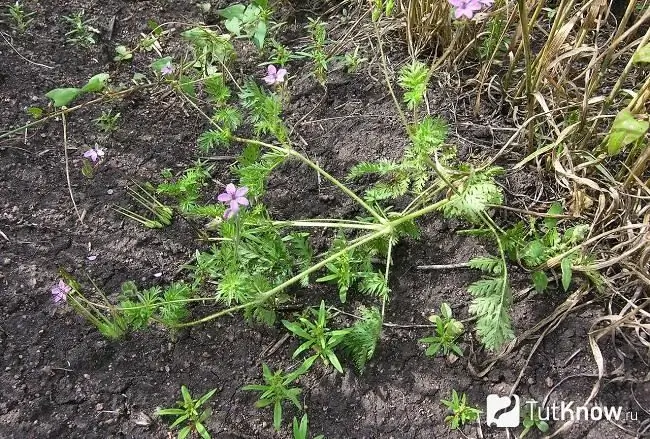
- Choosing a landing site. The rake prefers only open places that are constantly illuminated by the sun's rays. Therefore, flower beds with such plants should be located in the southern location. Even light shading is harmful to any type of needle case. It is recommended to plant storks in rockeries, stone gardens or alpine hills. Even if mulch from stony crumbs is laid on the flower bed, the plant will not take root there. Often this bush is planted as a tapeworm, which should fill the gaps between the stones, while it will grow and fill the free space with leaf pillows, giving the impression of wild thickets. Indoors, if the stork is planted in containers, then they can decorate recreation areas or gardens of potted crops on terraces and balconies. But if you want to grow a number of other representatives of the flora, then you should think about it well, since storks suppress them with their dark green pillow-like thickets, while the shortcomings of the former will be visible "in full view." Even nondescript bushes of styloid phlox or chickweed that have lost their flowers will seem very neglected against the background of the rake.
- Soil selection. This plant prefers substrates with increased drainage properties. Regardless of how fertile the soil is for the stork, it will work if it allows enough air and water to flow to the roots. Ordinary garden soil can be used. But there are some varieties that have certain requirements for growing. For Stork Reichard and Corsican it is recommended that there is enough calcium in the soil. If the soil is fertile, and not depleted, then this will lead to the death of the Maneskavi stork. All other species are cultivated using a more fertile substrate. But for any variety of rake, the soil mixture must have a weakly lime reaction.
- Fertilizers. Since the needle holder prefers mainly to grow on poor soils, then fertilizing is applied to him only when planting in the hole, they are no longer used. If you want to achieve more lush flowering, then you can apply top dressing twice: once before the buds begin to open, and the second time after flowering. Complex mineral preparations are used.
- Watering. Basically, storks are drought-resistant plants, but if there is no rainfall for a long time, especially during the flowering period, it is recommended to deeply water the bushes, while not allowing the soil to become waterlogged. For active growth of seedlings, systemic watering is recommended.
- General care. Mulching the soil around the plant will prevent the stork from getting wet. They use stone chips or aquarium soil from crushed stones. Shaping the bushes is not needed, but if they grow strongly, then pinch the tops of the shoots.
- Stork wintering. Each species of rake has different winter hardiness. Observations show that Reichard's stork tolerates frosts better - you don't even need to cover it for the winter months. If the soil is selected with good indicators of drainage, then the golden stork can withstand wintering without shelter. The Maneskavi stork is not as hardy as the previous species, but it will survive the winter only if an air-dry shelter is organized for it.
Florists prepare such a device from a layer of dry foliage or soil, from which heaps are created around the rake, and then a frame is installed on them. A non-woven material is pulled on the base, spruce branches are placed and strengthened on top of it. The same shelter is recommended when growing the Corsican and Heliantholist stork species. But many growers are of the opinion that it is better to keep the latter plant in an alpine greenhouse or planted in containers, so that later it can be transferred indoors for the winter period.
How to breed a rake?
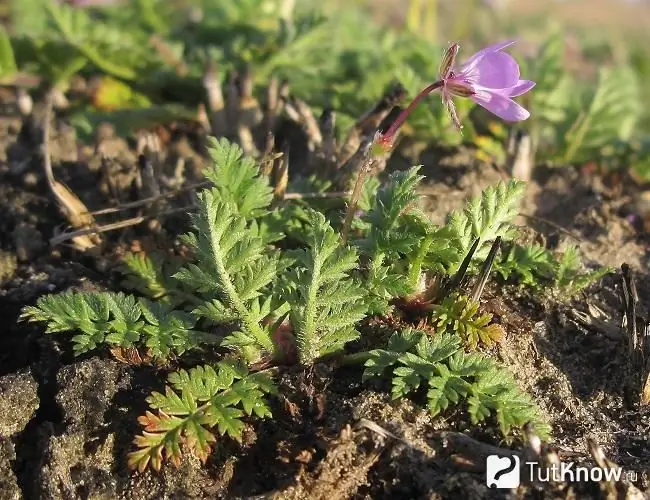
To get a new stork plant, various methods are suitable: seed and vegetative (dividing a bush or cuttings).
The seed is placed in the soil immediately after harvest or in the spring. The beds are prepared small, the soil must have good drainage. The planting depth of seeds usually does not exceed 2 cm. Often, flower growers are engaged in growing seedlings in boxes with peat-sandy soil. Then the seeds are sown immediately after they are removed from the plant. Containers with seeds are placed in a well-lit place, but without direct sunlight. In this case, the temperature is maintained within 10-16 degrees. The box is covered with glass or wrapped in transparent polyethylene. In this case, the sprouts will appear in a month. It is important to ventilate and, if necessary, water the soil. Also, self-sown plants can act as seedlings of a stork if the seedlings are not removed from the maternal specimens.
With the arrival of spring, it is possible to divide an overgrown rake bush. Even in spite of the presence of a taproot, the cushions of a plant are always formed by several dozen specimens. Then such leaf formations can be neatly divided into 2-3 parts. It is necessary that the delenki be large, so they take root more easily and start growing faster. The units are landed at a new, previously prepared place. Before planting, you need to put a drainage layer in the hole and combine the soil with humus or compost.
If a decision is made to carry out cuttings, then only species with a woody form of growth (for example, the Maneskavi variety). In the spring, blanks are cut from the tops of the stems. In this case, the length of the branches should be 7-8 cm. It is recommended to treat the cuttings with growth stimulants. Then they are planted in pots filled with a peat-sand mixture, or the garden soil is combined with coarse sand. You can spray the soil with stimulants and then the cuttings will no longer require processing. You need shelter, which is a glass jar or a cut plastic bottle. If you constantly keep the soil moist, then the twigs take root for about a month. Then you can plant young storks in prepared holes in a flower bed. Before planting, drainage and organic fertilizers are placed in the hole.
Diseases and pests that annoy the stork
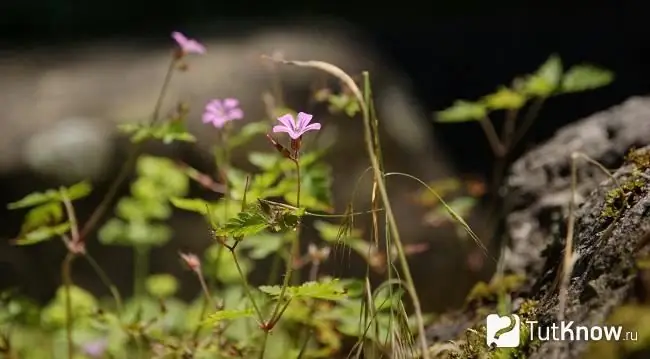
The plant has excellent disease resistance and does not suffer from harmful insects. The biggest problem when caring for it when growing in the garden is a waterlogged substrate and high humidity. These factors can provoke putrefactive processes, and then the rake is affected by fungal diseases and infections. If spots begin to appear on the leaf plates, then it is recommended to carry out treatment with fungicidal preparations.
The same troubles can be provoked by planting in a too heavy substrate. Then not only treatment with disinfecting drugs is carried out, but also transplantation using disinfected soil.
Facts to note about the rake, plant photo
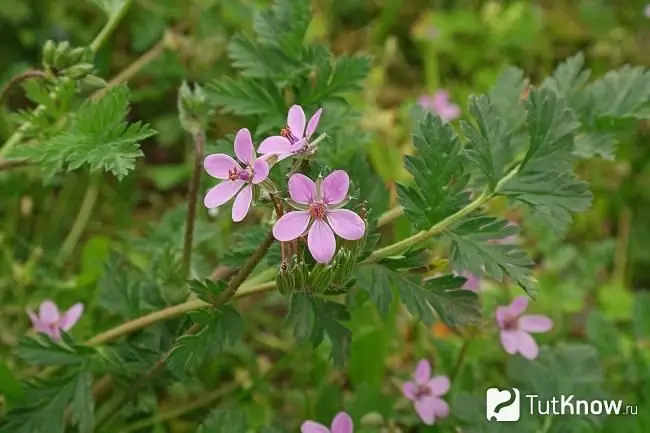
The plant has long been known to folk healers or homeopaths, since the spectrum of its action is very wide. This includes astringent and anticonvulsant properties, as well as the ability to stop blood. If a tincture is prepared from a part of a stork growing above the soil, which is taken orally, then it has a pronounced homeostatic effect, due to its property to reduce the permeability of the walls of blood vessels. In this case, there is a calming effect of the central nervous system and cells of the cerebral cortex.
Tincture of garabelik was used by traditional healers for a remedy for insomnia, which could calm even a very nervous person, especially children or the elderly. With it, festering and non-healing wounds are washed. Due to the latest characteristics, products based on stork are widely used in cosmetology. If there are symptoms of a cold or pneumonia, pleurisy, or bloating, then homeopaths recommend taking a decoction of a needle holder. The same remedy can be used for hemorrhoids, diseases in the field of gynecology and angina pectoris. If you take baths with stork grass, it helps to eliminate the manifestations of childhood diathesis, soothes the nerves of a frightened child and even leads to the cessation of the convulsive state.
When an animal has a wound, healers have sprinkled it with powder from dried garbel herb for a long time. Also, breeders know that magpie needles are one of the most useful feed for sheep. Moreover, the plant is considered an excellent honey plant.
Stork species
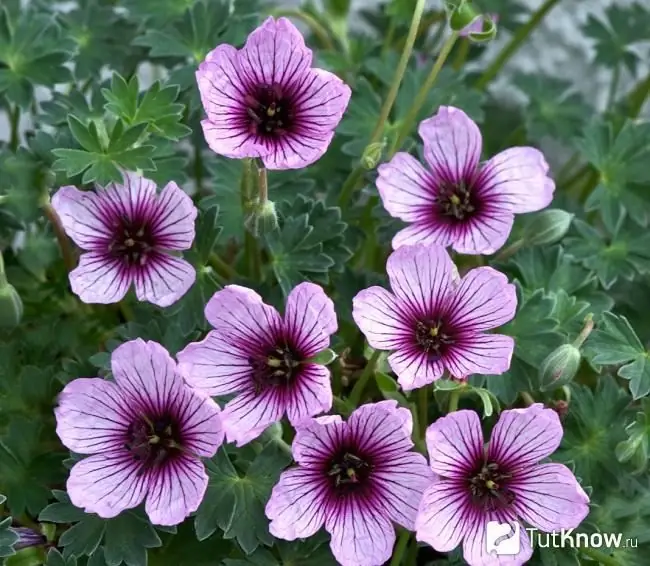
- Reichard Stork (Erodium reichardii). Bears the name Dubrovnikovidny Stork. The density of leaf cushions is very high, they reach 20 cm in diameter. The leaf is oval, gray-green in color, has a powerful petiole. There is a beautiful vein pattern on the surface. The edge of the foliage is carved. The flowers crown the flower-bearing stems one by one, towering 15 cm above the foliage. Since the flower stalks are shortened, the flowers seem to lie on a deciduous pillow. The color of the petals in the flowers is white or light pink with an oval or obovate shape. There are streaks of reddish-purple color on the surface. Their length is 1, 5 cm. Flowering occurs in June-July.
- Corsican Stork (Erodium corsicum) it has a height of only 10 cm, with a slightly larger diameter of a deciduous pillow, characterized by a strong density and density. Leaves with a velvety gray coating. The flowers seem to be large in size against the background of the pillow. Petals in large flowers are practically closed, their color is whitish-pink. With a surface pattern of bright cherry veins.
- Golden Stork (Erodium chrysanthum). The plant is characterized by slow growth, its flowers are similar to those of a daffodil. Flowers are dioecious, and the female form has yellow petals with a surface in dark veins and pistils of a purple tone. Male flowers are distinguished by creamy petals and snow-white veined patterns and pink anthers. The leaf plates have narrow lobes, which is why they look curly and dense, while from a distance they look like needles, but since there is a grayish-silvery pubescence, it is clear that this is a herbaceous perennial. The length of the peduncles is 15 cm. The flowers are combined into a bundle-shaped inflorescence of several buds.






